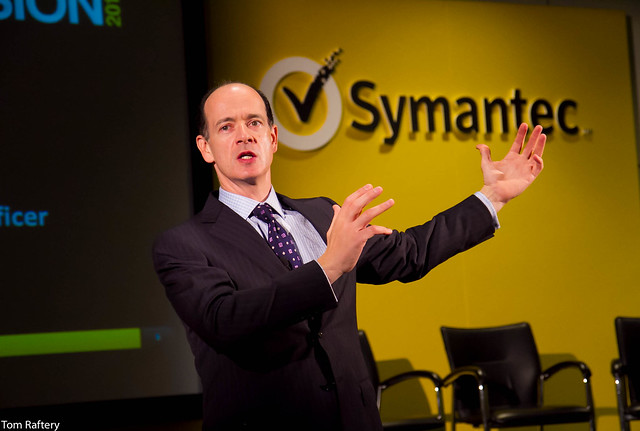I attended Symantec’s Vision 2010 event in Barcelona yesterday and I found it to be hugely frustrating!
Symantec are one of the world’s largest computer security companies with 31,000 customers, 18,400 employees (PDF), and revenue in 2009 of $6.2 billion.
At yesterday’s Vision event however, they missed lots of great opportunities to talk up their Green story! I sat through the keynote from CEO Enrique Salem and presentations from the business unit leads and there was not one mention of the word Sustainability or even Green.
Deepak Mohan, SVP of the Information Management Group came closest when he mentioned efficiencies associated with de-duplication, eliminating redundancy, reducing data transfer and more efficient (that word again) search. Guys, these are obvious Green wins!
Things improved considerably in the afternoon when Fujitsu, a Symantec customer, spoke about the payback from installing a hosted email filtering solution from Symantec. Before the installation, Fujitsu were receiving in excess of 2m emails per day. Between 90-95% of these emails were spam. After the rollout of the email filtering solution, Fujitsu are now receiving 5-10% of their previous email load per day. As a consequence they were able to reduce their email infrastructure from sixteen servers down to two. Furthermore, they were able to reduce their network link requirements and their storage requirements for email. And finally they were able to free up IT resources who previously were tasked with managing the email infrastructure. This is a big Green win!
Later in the afternoon I was especially heartened to have a one-to-one session with Symantec VP of Global Solutions, Jose Iglesias. Jose is the guy raising/waving the Green flag within Symantec. He informed me that Symantec have used their own technologies to reduce the electricity bill in their data centers by $3m (10%) per annum!
How do they do this?
Symantec has software for helping manage computer clusters which can help you reduce the number of computers in a cluster without affecting your SLA’s.
Also, according to Jose, storage costs can represent between 25-75% of a data center’s energy spend. To help with this Symantec have storage management products which give deep visibility of use of storage. This can highlight overallocation, help reclaim storage space and defer the purchase of new storage.
Other technologies like dynamic storage tiering can significantly reduce the amount of energy used in storage while data deduplication can free up large amounts of disk space.
Symantec also have software which can put computers to sleep after a set period of inactivity and they have partnered with TechTurn to manage end of life computers
Finally, Symantec see a large role for themselves in helping secure the Smart Grid.
With all these Green credentials, why aren’t Symantec screaming their Sustainability story from the rooftops?
Possibly because they don’t see it as core to their customers’ needs. That is changing. Fast.
Another good reason for Symantec to strt talking up their Green credentials is that companies with a good record on Sustainability have an easier time attracting and retaining employees – something which is vital to the long-term sustainability of any company.





